Nestled in the serene town of Sarangpur, Gujarat, stands the awe-inspiring Sarangpur Temple, a revered sanctuary dedicated to Lord Hanuman – the remover of all sorrows. Renowned for its divine power and mystical rituals, this temple is not just a place of worship but a haven of healing for the soul. Whether you seek spiritual solace or a miraculous escape from life’s hardships, Sarangpur Temple promises an unforgettable experience. From its powerful exorcism rituals to its awe-inspiring architecture, this blog covers everything you need to know about this legendary temple. Dive in, and let the magic unfold!
Location
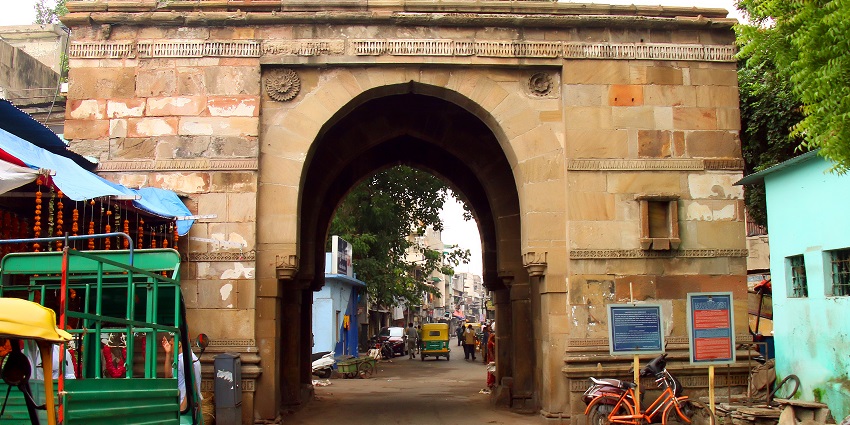
Photo: Tejaherwal / Wikimedia Commons
The Sarangpur Temple address is in the quaint village of Sarangpur in the Botad district of Gujarat. Placed approximately 165 kms from Rajkot and 150 kms from Ahmedabad, it is easily accessible from major cities in Gujarat. The temple lies in a scenic, tranquil setting, surrounded by rural landscapes that enhance its spiritual ambience.
Suggested Read: Top Mahadev Temples In Gujarat For A Spiritual Experience
How To Reach Sarangpur Temple
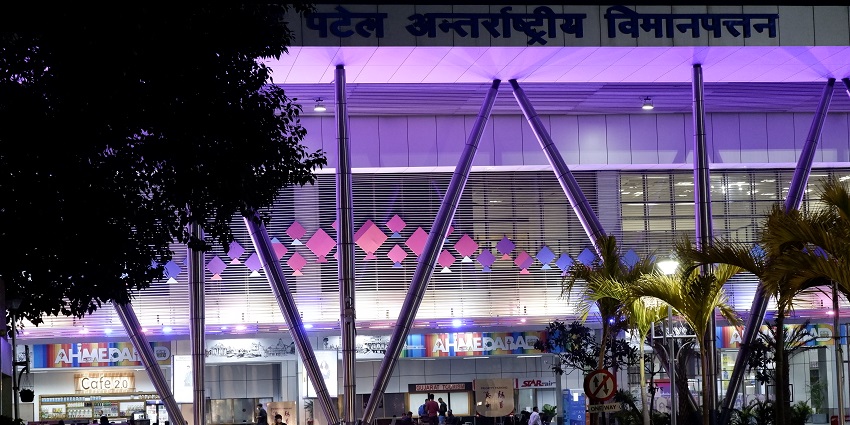
Photo: Apurba Biswas / Wikimedia Commons
Sarangpur Temple is well-connected to major cities in Gujarat, making it accessible for pilgrims and travellers alike. Here’s how you can get to this divine destination:
By Air: The nearest airport is Sardar Vallabhbhai Patel International Airport in Ahmedabad, approximately 150 kms away. Regular taxis and buses connect the airport to Sarangpur.
By Train: The nearest railway station is Botad Junction, 20 kms from the temple. You can hire taxis or autos from the station.
By Road: Sarangpur is well-connected by road. You can take state transport buses or drive from Ahmedabad (150 kms) or Rajkot (165 kms).
Places To Visit Around Sarangpur Temple
Your visit during Sarangpur Temple timings will be a major spiritual experience. However, the surrounding areas also offer remarkable places that are worth exploring, including:
1. Ghela Somnath Temple
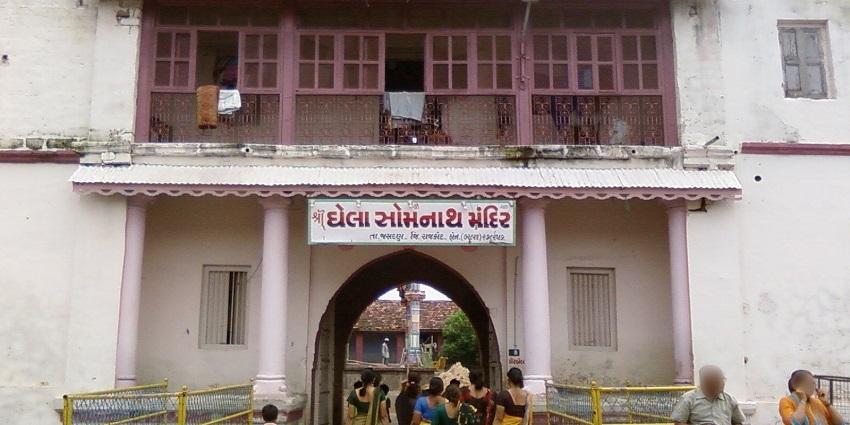
Photo: Tekina / Wikimedia Commons
Located about 40 kms from Sarangpur, the Ghela Somnath Temple is dedicated to Lord Shiva. It is believed that the lingam here is self-manifested, making it a sacred destination for devotees. The temple is situated on the banks of the Ghela River, offering a tranquil ambiance for meditation and spiritual reflection. The temple also attracts many pilgrims during the Shivratri festival, where special pujas are held. It’s a perfect place to experience serenity while being surrounded by nature, with the river providing a soothing backdrop for spiritual rejuvenation.
Timings: 6 AM – 8 PM
Entry Fee: Free
Suggested Read: Hanuman Temples In Gujarat
2. Shri Jalaram Bapa Mandir, Virpur

Photo: RAJUKHAN SR RAJESH / Wikimedia Commons
Situated approximately 50 kms from Sarangpur, this temple is dedicated to the revered saint, Jalaram Bapa. Known for its rich history and spiritual significance, devotees come from far and wide to seek blessings and witness the original belongings of Jalaram Bapa. The temple complex includes a museum that showcases items used by the saint, adding depth to the experience. A free meal, or Prasad, is served daily as part of the temple’s tradition of selfless service. Visitors can also participate in bhajans and kirtans held in the temple’s open courtyard.
Timings: 6 AM – 12 PM, 4 PM – 8:30 PM
Entry Fee: Free
3. Nishkalank Mahadev Temple, Bhavnagar
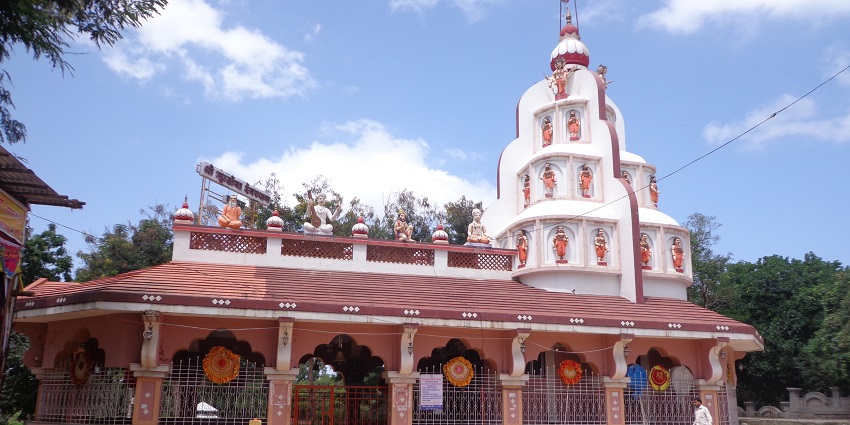
Photo: Swapniliscreative / Wikimedia Commons / Image For Representation Only
Located about 80 kms from Sarangpur, this temple is unique as it is submerged during high tide and emerges only during low tide. Dedicated to Lord Shiva, the temple is said to have been built by the Pandavas after the Kurukshetra war. To visit the temple, devotees must walk through the shallow sea at low tide. The panoramic views of the Gulf of Cambay enhance the temple’s spiritual vibe. The Nishkalank Shivalingas are spread across five different shrines in the middle of the sea. Many devotees come to perform rituals and pujas at low tide.
Timings: Accessible during low tide only
Entry Fee: Free
Suggested Read: ISKCON Temple In Ahmedabad
4. Swaminarayan Mandir, Gadhada
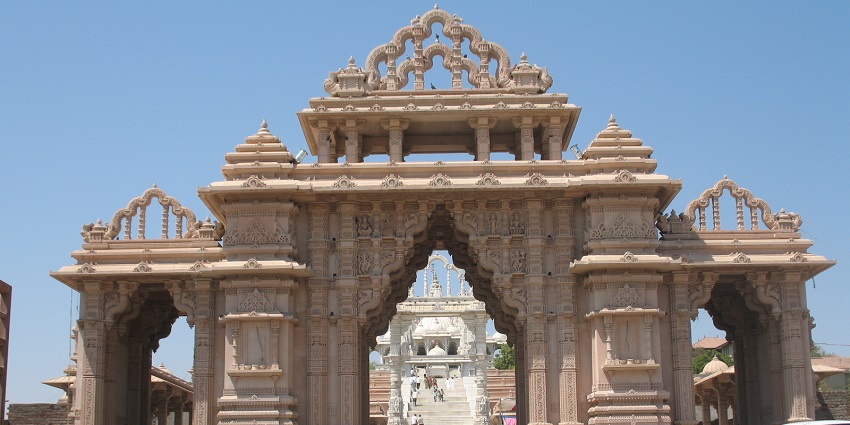
Photo: Raman Patel / Wikimedia Commons
About 35 kms from Sarangpur, the Swaminarayan Mandir in Gadhada is a major pilgrimage site for followers of the Swaminarayan sect. The temple is beautifully adorned and holds deep spiritual significance as Lord Swaminarayan spent many years here. The large temple complex includes a holy pond. The intricate carvings on the temple walls and the peaceful gardens add to the grandeur. The main hall houses a beautifully adorned murti of Lord Swaminarayan. There is also a library where devotees can read religious scriptures and texts.
Timings: 6 AM – 8 PM
Entry Fee: Free
Where To Stay

Photo: Aniruth Salla / Pexels / Image For Representation Only
When visiting Sarangpur Temple, there are several accommodation options available to suit all budgets. The temple itself offers Dharamshala (guesthouses) with basic facilities, providing affordable lodging for devotees. For a more comfortable stay, nearby towns like Botad and Bhavnagar offer hotels ranging from budget-friendly to mid-range options, ensuring convenience and a restful experience. Some popular choices include Hotel Sarangpur Palace and Hotel Shreeji, both offering clean rooms and essential amenities.
Suggested Read: A Pilgrim’s Guide To Jain Temples In Gujarat
Where To Eat
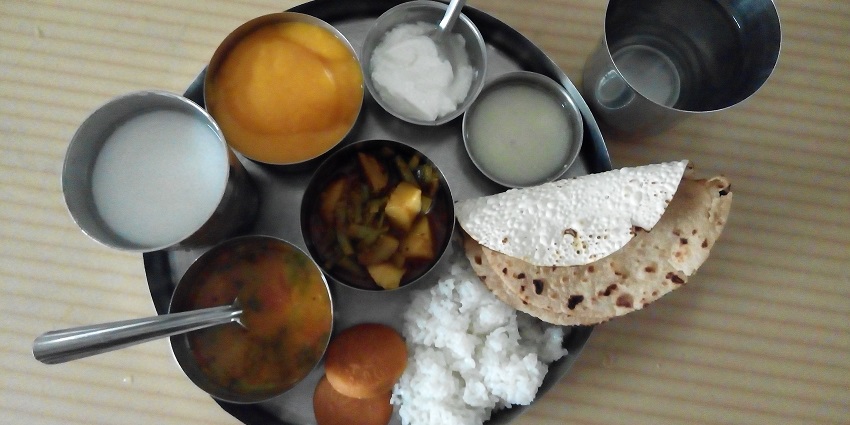
Photo: Shivkatira / Wikimedia Commons / Image For Representation Only
When visiting Sarangpur Temple, you’ll find a variety of simple yet satisfying food options. The temple’s prasad hall serves free, freshly prepared meals to devotees, providing a wholesome, traditional vegetarian experience. For those looking for other options, small eateries and local food stalls near the temple offer delicious Gujarati dishes like dhokla, thepla, and farsan. Nearby towns like Botad have small restaurants and dhabas serving authentic Gujarati thalis.
Best Time To Visit

Photo: Vijay8808 / Wikimedia Commons / Image For Representation Only
The best time to visit Sarangpur Temple is between October and March, when the weather is cool and pleasant, making it ideal for exploration and spiritual activities. During this period, the temperature ranges from 15°C to 25°C, offering comfortable conditions for travel and remarkable Sarangpur Temple photos. This season also coincides with several religious festivals, including Hanuman Jayanti, which draws large crowds of devotees, adding a vibrant atmosphere to the temple experience. You should avoid visiting this temple during the summer months (April to June), as temperatures can soar above 40°C, and the monsoon season (July to September), which may bring heavy rains and disrupt travel plans.
Suggested Read: Shiva Temple In Gujarat In Sea
Other Factors To Consider
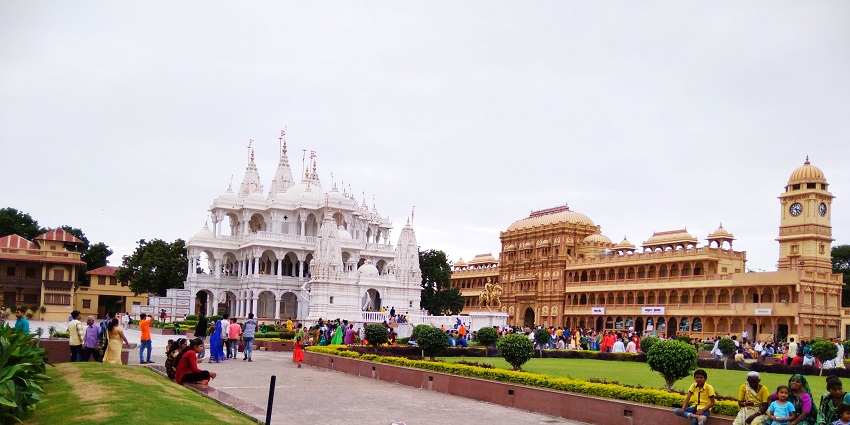
Photo: JEEGNESHBHAI GANPATBHAI SONAGARA / Wikimedia Commons / Image For Representation Only
When planning a trip to Sarangpur Temple Gujarat, consider these factors for a smooth visit:
- Limited Amenities: Bring essentials like water and snacks, as nearby facilities may be sparse.
- Respect Local Customs: Follow temple rules and practices to show reverence and enhance your spiritual experience.
- Festival Calendar: Check the temple’s festival schedule to avoid overcrowding or to join in special celebrations.
- Travel Advisories: Be aware of local travel conditions and road statuses, especially during the monsoon season, for a safe journey.
Sarangpur Temple isn’t just a destination; it’s a transformative journey for the soul. With its divine aura, mystical rituals, and the serene charm of Gujarat’s landscape, this sacred haven promises a profoundly enriching experience. Imagine standing before the mighty Hanuman, feeling the tranquillity of ancient rites, and immersing yourself in the vibrant local culture. Every corner of Sarangpur offers a unique blend of spirituality and heritage, urging you to embark on this unforgettable pilgrimage. Book your holiday with TripXL for a serene experience.
Cover Photo: Rahilarious / Wikimedia Commons / Image For Representation Only


 WhatsApp
WhatsApp
 Twitter
Twitter









